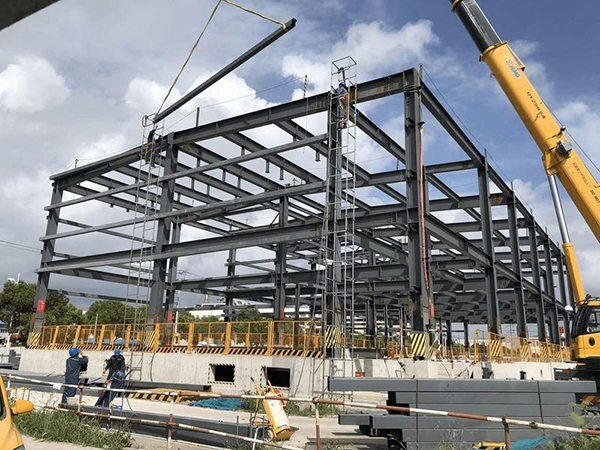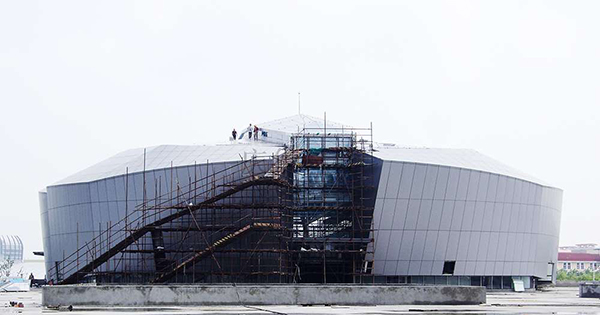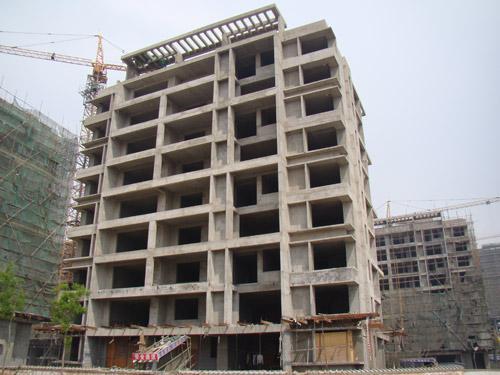【Xtd Steel Construction-Shanghai Songjiang Stadium】
1. Advantages comparison
Compared with traditional buildings, steel structures have significant advantages in many aspects. For example, in terms of earthquake resistance, steel has plasticity and toughness far exceeding that of masonry, and its earthquake resistance is much better than that of brick houses. In terms of weight and load-bearing capacity, although steel structure components are lighter, their load-bearing capacity is much higher than that of brick-concrete structures, achieving a perfect combination of lightness and firmness. In terms of manufacturing precision, steel structures use modular operations to simplify the manufacturing process, which not only improves the precision of the structure but also enhances the sealing. In terms of construction period, the construction period of steel structures is at least half the time of traditional buildings, greatly improving the construction efficiency. In terms of environmental protection and energy saving, steel-structured houses have low pollution levels during construction, and 100% of the waste after steel is scrapped can be recycled and reused, making them an ideal choice for developing a low-carbon economy.
2. Material maintenance cost
1. Steel structure
- During use, steel structures are susceptible to external environmental influences such as moisture and corrosion, and require regular maintenance. For example, steel structures need to be treated with anti-corrosion treatment, such as anti-rust paint and fire-retardant paint; at the same time, the connection parts of the steel structures need to be checked regularly to ensure the safety of the structure. These maintenance tasks require a certain amount of manpower, material, and financial resources, which increases the cost of using steel structures.
1. Traditional building materials
- Brick-concrete structure: The maintenance cost is relatively low. As long as the quality is guaranteed during the construction process, under normal use, large-scale maintenance work is generally not required. However, over time, the brickwork may develop cracks, weathering,g and other problems, which require appropriate repairs.
- Concrete structure: Concrete structure has good durability and relatively low maintenance cost. However, if there are cracks, steel bar corrosion, and other problems in the concrete structure, they need to be dealt with in time, otherwise,e it will affect the safety and service life of the structure.
3. Construction costs during construction
1. Steel structure
- Steel structure construction requires professional construction teams and equipment, and construction workers need to have a high level of skills to ensure the installation accuracy and quality of the steel structure. This makes the labor cost of steel structures relatively high. In addition, large mechanical equipment such as cranes and electric welders are also required during the construction of steel structures. However, the construction speed of steel structures is relatively fast, which can shorten the construction period of the project and reduce the additional costs caused by delays in the construction period.
- Adaptability: Steel structures are more resistant to severe weather and can reduce additional costs caused by weather delays.
- High space utilization: Due to the high strength of steel, the cross-section of components under the same load-bearing conditions is smaller, which can increase the effective use area of the building and indirectly improve economic benefits.

[Xtd Steel Construction-Shanghai Substation Modification Project]
1. Traditional Architecture
- Concrete pouring requires professional construction personnel and equipment. During construction, attention should be paid to the concrete mix ratio, pouring sequence, and vibration quality. Although the construction technology of concrete structures is mature, the labor cost and equipment costs are slightly higher than those of brick-concrete structures. It has good integrity and durability and can meet construction projects with high requirements for structural performance.
[Pictures from the Internet]
The initial construction cost of traditional building materials (such as concrete) is usually lower than that of steel structures.
In bridge projects, the initial investment in steel structures is also generally higher than that in concrete structures, mainly due to the high price of steel and the complex processing technology.
4. Material procurement cost
- Steel structure materials: As the main component of steel structure, the price of steel is affected by many factors such as market supply and demand, raw material price fluctuations, and international economic situation. In recent years, the price of steel has fluctuated. Generally speaking, the unit price of high-quality steel is relatively high. Since the design and manufacturing of steel structure components are relatively standardized, the material utilization rate is high, which can reduce the cost of material waste to a certain extent.
- Traditional building materials: The main raw materials of concrete include cement, sand and gravel, water,r, and admixtures. The price of cement is relatively stable, and the supply of raw materials such as sand and gravel is sufficient in some areas and the price is relatively low. However, the amount of concrete is usually large, and it needs to be mixed on-site or purchased as premixed concrete. Transportation and pumping will also increase certain costs.
In terms of material procurement costs, the initial purchase price of steel structures may be higher, but considering factors such as material utilization, the actual material cost is not necessarily much different from that of traditional building materials.
[Daily Steel Prices:
Daily Steel Prices ]
5. Environmental protection and policy dividends
As the global carbon neutrality goal is promoted, the environmental protection attribute of steel structures will become a key competitive advantage.e
- Lower carbon emissions: Prefabricated buildings will reduce dust and waste caused by on-site construction, and carbon emissions from steel production can be further reduced through green electricity technology.
- Government support: Many countries have provided subsidies or tax incentives for prefabricated buildings.
When choosing materials, we must not only consider the cost but also the impact on the environment. In modern architecture, environmental awareness is constantly increasing. Steel is
100% recyclable and has a much smaller burden on the environment than traditional materials.
Summarize
Through the analysis of material procurement costs, construction costs, and maintenance costs, it can be seen that steel structures and traditional building materials have their advantages and disadvantages in terms of cost. In some projects with high requirements for construction periods, large building space, and high requirements for structural performance, although the material procurement cost of steel structures may be slightly higher, its advantages such as fast construction speed and low construction cost can effectively reduce the overall cost of the project.
In some small buildings, or projects with special requirements for architectural style and more sensitive to maintenance costs, traditional building materials may have more cost advantages. At the same time, in the future, with the popularization of green steel technology and intelligent construction, the cost competitiveness of steel structures will also be further developed and improved, becoming a powerful substitute for traditional buildings.


